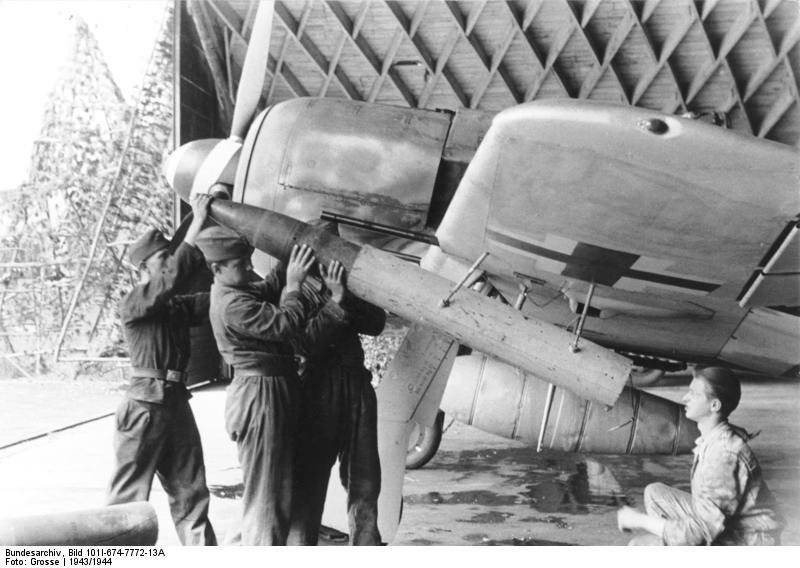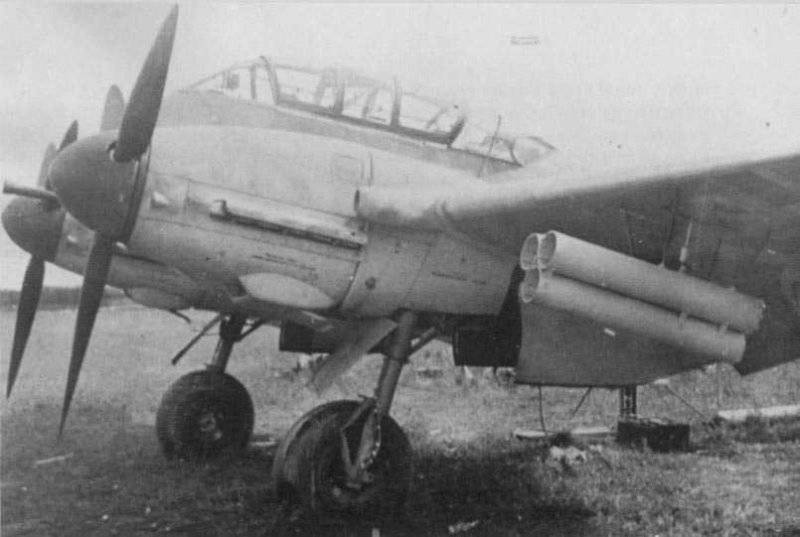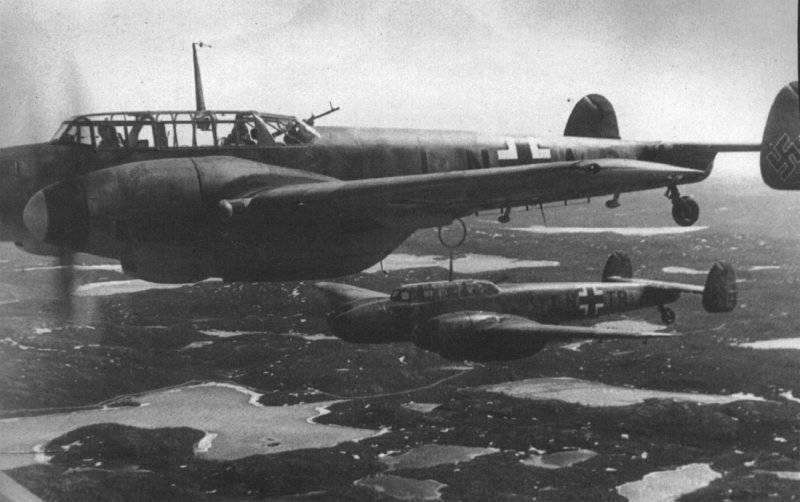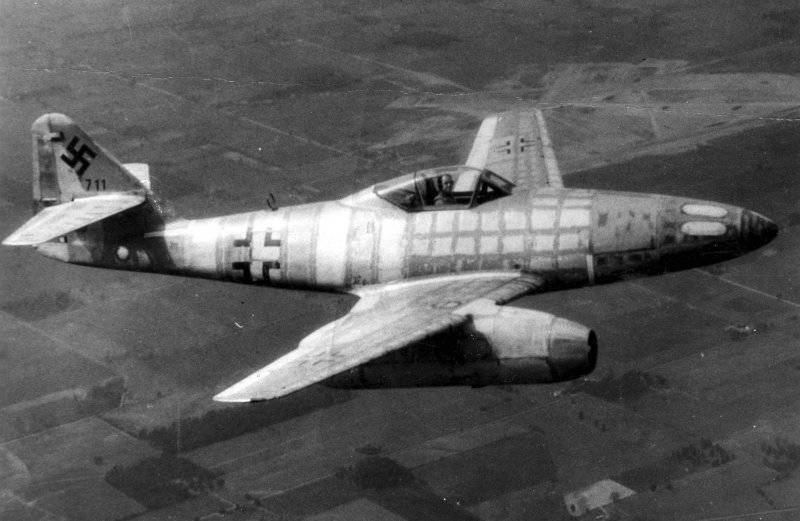German unmanaged aircraft
In Germany, work in the direction of unguided aircraft rockets (rockets according to the then Soviet classification) began as early as 1937. Designers of the company Rheinmetall-Borsig proposed to use the available developments on the topic of missiles in the field of aviation. It was assumed that the high speed of such a projectile will provide a quick and reliable defeat of the enemy aircraft, located at a relatively short distance. Aim for new weapons first of all, enemy bombers were to become slow and awkward. However, as of 1937, the design of existing unguided rockets did not allow small targets to be fired. The deviation of the missiles from the calculated trajectories had completely unacceptable values; even the rotation of the missile in flight did not help. Only in 1941, did Rheinmetall's specialists manage to achieve deviations of just one-fortieth from the distance traveled.
In 1943, an unguided rocket Wfr.Gr. was sent for testing. 21 (Wurframmen Granate 21 - "21 caliber throwing grenade cm"), created on the basis of ammunition for Nebelwerfer rocket launcher. A shell length of 1260 millimeters weighed 110 kg, the mass of the explosive charge was 38,6 kg. In the rear of the projectile there was a solid fuel engine that provided speeds up to 300-320 meters per second. In the design of Wfr.Gr. 21 used one original solution: the projectile stabilized in flight while flying, but did not have any stabilizers or the like. planes. The fact that the powder gases of the engine expired immediately through several nozzles. One, central, had a large size and worked as a sustainer engine. Around the main nozzle there were 28 additional small nozzles deflected from the horizontal axis. During the flight, a part of the powder gases was ejected through small holes, which gave the projectile rotation. In Soviet and Russian terminology, such a stabilization scheme for a projectile is called a turbojet. The stock of solid fuel was enough for a flight over a distance of about seven kilometers. Of course, the shooting at aerial targets was planned to be carried out from much shorter distances.

The absence of protruding structural elements allowed to do for Wfr.Gr. 21 is a very simple launcher. It was a banal pipe about a meter and a half long with attachment systems to the carrier and electrical wiring. The launch tube, like the rocket, was borrowed from a ground mortar, but received new mounting brackets. The suspension system made it possible to fix launch tubes with rockets on standard bomb racks and, if necessary, to drop them. Such weapons were installed on the Fokke Wulf FW-190A aircraft, issued for testing. The design of the fighter allowed hanging under the wings of one launch tube and another one, if necessary, under the fuselage. Trial shooting at the site confirmed all previous assumptions: missiles Wfr.Gr. 21 really could effectively hit enemy aircraft. Hit of ammunition with 38 kilograms of explosives guaranteed to destroy even heavy bombers. At the same time, the enemy's plane still needed to get there, but it was very difficult. However, in the early summer of 1943, the unguided rocket Wfr.Gr. 21 adopted and sent to the troops. It was recommended to use it with FW-190A fighters, which, after being equipped with launch tubes, received an additional R6 index, or with Bf-110 fighters. On the "Messerschmitt" suspended both two and four missiles.
The first combat use of missiles Wfr.Gr. 21 was held on 17 August 1943, during the famous "Schweinfurt meat grinder." After a raid on targets in the cities of Schweinfurt and Regensburg, the American pilots missed the X-NUMX B-60 bombers and eleven more returned to the bases literally like in that song, "on parole and on one wing" - in non-repairable condition. A certain number of aircraft were shot down by unguided rockets. In addition, one feature of the missiles became clear: the explosion of the missile warhead not only destroyed the aircraft, but in some cases seriously damaged its “neighbors” in order of battle. Of course, the success of the German fighters, among other things, was due to the lack of cover for the Allied aircraft, but Wfr.Gr. 17 confirmed its usefulness. In the future, unguided rockets of this model were repeatedly used in a combat situation. Over time, the fighter pilots stopped trying to get into enemy aircraft and began to use Wfr.Gr. 21 as a kind of distraction. It became especially effective during night flights: a howling and belching flame the projectile distracted shooters of the American and British bombers, thanks to which the German could relatively calmly carry out the attack. Another original use of Wfr.Gr. rockets. The 21 was connected to the third launch tube under the fuselage of the FW-21A fighter jets. Some pilots loaded the rocket backwards. Thanks to this, going on the target, two missiles could be fired, and at the exit from the attack, letting the third one “behind my back”. Naturally, the accuracy of the third launch was even lower than that of the first two, but the number of missiles launched sometimes turned into quality.
And yet this “quality” had an insufficient level, so it was decided to increase the number of fighters carried by the fighter. Especially for the Me-410 fighter, an original launcher for six Wfr.Gr. rockets was developed. 21. A drum with six launch tubes was installed at the bottom of the fuselage. Missiles were launched in pairs through special windows in the nose of the aircraft. For the release of powder gases, similar tubes were mounted behind the launcher. Before starting, the drum with the rockets was turned, the powder engine was ignited, and then the process was repeated. However, this was the case only in theory. In practice, everything went completely wrong. To test on the basis of the airframe Me-410, an experimental stand was assembled. During the very first launch in February 1944, the prototype of the drum set was almost completely destroyed. Even before the launch of the launch tube, the rocket began to rotate and scatter hot gases around it. Their pressure was so powerful that the aircraft skin could not stand it and collapsed. About any continuation of work in this direction of speech no longer went.
At about the same time, another incident occurred during the testing of another turbojet. This time it was planned to equip the Bf-110 fighter with one launcher for the RZ-100 rocket of the 420 caliber of millimeters. The 730-kilogram rocket carried the 245 kg of explosive and could fly several kilometers. It was assumed that in the future, heavy fighters with the help of these missiles would "knock out" the enemy's small-caliber anti-aircraft artillery, without entering its zone of destruction. As in the case of the Me-410, a test bench was assembled. On the nose of the airframe Bf-110 put the starting guides and equipment of the electric fuse of the solid fuel engine. It is not difficult to guess how this experiment ended. The 85-kilogram block of solid fuel literally scattered the design of the aircraft. The nomenclature of promising systems of unguided rocket armament for aviation was reduced by one more line.
Until the very end of World War II, the Germans used Wfr.Gr. 21 exclusively from suspended launchers. The relatively successful experience of their use quickly served as a reason for proposing an expansion of the range of jet weapons for fighters. By the end of 1943, the launcher-based launcher was ready for construction, from which 28 cm WK rockets, borrowed from 28 cm Nebelwerfer 41 rocket mortar, could be used. With the same length as Wfr.Gr. 21, 28 cm WK missiles had a larger caliber (280 mm) and a large warhead mass (50 kg). At the same time, the 280-mm missiles were lighter (82 kilograms) and slower - they only accelerated to 150 m / s. In view of the low accuracy, missiles of all types were used exclusively in attacks of large compounds of enemy bombers, which, nevertheless, also did not give high effectiveness. Regardless of weight and speed, aviation missiles based on ground-based Nebelwerfer had the same characteristic features. The plane could not physically carry a large number of them, and the available two or three missiles were more often a useless load or a means of psychological influence than a reliable and effective weapon.
In the second half of 44, the most promising scheme of an unguided rocket began to be considered a rocket projectile rotating in flight due to the angle of the stabilizers. Such shells did not scatter powder gases around themselves and did not threaten the design of the aircraft. However, the scale of the stabilizers could cause difficulties in creating launchers. As a result, the first ammunition with such a stabilization system in flight - RzHV 8 caliber 76 millimeters - did not go to the series. The stationary stabilizers with a 220 span of mm did not allow more than eight missiles to be suspended under the wings of Bf-110 aircraft. However, the characteristics of the RzHV 8 were quite acceptable. A missile weighing just over 10 kg carried about a kilogram of explosive and accelerated to 750 m / s. The deviation from the intended trajectory was 1 / 35 from its length. And yet, despite the non-folding stabilizer, the RzHV 8 had quite good prospects. As many as eight missiles, even with a relatively small charge, in air combat could be much more effective than two heavy Wfr.Gr. 21.
Understanding this, the leadership of the German air force ordered a similar missile, but with the possibility of a more dense layout of launchers. In the winter of 45, the firm Curt Heber Maschinen-Apparate-Fabrik completed the development of an unguided rocket R4M. The solid propellant had a total weight of 3,85 kg and a length of 81 centimeter. The warhead of the rocket weighed 500 grams, which, however, was considered sufficient. As practice has shown, the multi-kilogram charges of previous heavy rockets in most cases turned out to be ineffective due to misses. For the destruction of the aircraft, in turn, a small piece of explosive was enough. It was from these considerations that the transition from “quality” to quantity was made. R4M rockets had a caliber of just 55 millimeters. Opening stabilizer span 242 mm occurred after descent from the guide. Due to the small size and weight of the R4M rocket, it was possible to hang 12 units on special blocks. Thus, one FW-190F, Bf-110 or Me-262 aircraft could be armed with two dozen missiles at once, one under each wing. An interesting feature of the R4M was their ballistics. By coincidence, the trajectory of these missiles coincided with the trajectory of the 30-mm MK 108 automatic cannon, which helped the pilots to aim with the same sight, using the same corrections for the barrel and jet weapons.
Towards the end of the war, approximately 4 fighter jets, mainly Me-60, were equipped with launchers for the R262M. On six aircraft installed double launch blocks, which allowed to increase the ammunition of one fighter to 48 missiles. At the very beginning of 1945, the manufacturer ordered a large batch of 25 thousands of missiles. Only half of the order was completed by the end of the war. In addition, as a result of the bombing, most of the R4M missiles produced were lost during transport or in warehouses. During the first months of the 45, about two and a half thousand rockets were fired in a combat situation. Features of mass production led to a relatively low accuracy and probability of hitting. However, a volley of all 24 rockets often led to a result - when firing at a large bomber formation, one or two missiles reached the target. At the same time, the guesses about the effectiveness of the half-kilogram warhead were fully confirmed: a rocket hit the fuselage led to the guaranteed destruction of the B-17 or Lancaster.
Remarkable is the fact that the majority of German unguided aircraft missiles were intended for firing at air targets. However, there were exceptions. Seeing the effectiveness of Soviet armor-piercing missiles of the RBS series, the German designers made its counterpart. The 8 cm WK rocket, which was a processing of the Soviet M-8, was taken as a basis for it. The German rocket caliber 78 mm and length 70 cm weighed 6,6 kilogram and accelerated to 360-370 meters per second. The standard fragmentation warhead was replaced by a cumulative, normal-capable penetration to 90 mm of armor. New anti-tank ammunition received the name Panzerblitz I. The main carrier of these missiles were aircraft FW-190F-9.

All adopted Luftwaffe rockets were used until the very end of the Second World War. Basically they were created to combat air targets, although there were exceptions. The use of missiles reached its peak in the spring of 45. Given the difficult situation on the fronts, missiles designed for firing at aircraft were also increasingly used for ground attacks. Over time, the need to deter the attacking enemy led to the fact that Panzerfaust anti-tank grenade launchers began to mount anti-tank grenade launchers on training aircraft. It is easy to guess what the effectiveness of this technical solution was - in practice, far from all such attack aircraft could at least get to the target area. In general, a rather late appeal to the subject of missiles for aviation had rather unpleasant consequences for Germany. Serial production of sufficiently effective (when properly used) types of weapons in combination with the incorrect initial selection of targets for it eventually became one of the reasons for the defeat of the Third Reich. Well, the ideas of using a folding stabilizer or a large number of relatively small and light rockets later developed, but already in the victor countries.
On the materials of the sites:
http://ursa-tm.ru/
http://luftwaffen-projekte.de/
http://luftarchiv.de/
http://commi.narod.ru/
http://strangernn.livejournal.com/
http://cockpitinstrumente.de/
http://stormbirds.net/
http://airwar.ru/




Information